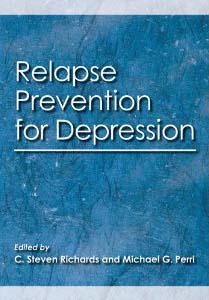Relapse Prevention for Depression

“Exceptional” resource gives readers prevention strategies
“Relapse Prevention for Depression”
Edited by C. Steven Richards
and Michael G. Perri
American Psychological Association
Washington, D.C., 2010
By James K. Luiselli, Ed.D., ABPP, BCBA-D
Approximately 20 million people in the United States experience serious depression. Although there are effective psychotherapy and pharmacologic treatments for this condition, many patients relapse after improving. Indeed, a somber conclusion echoed in this book is that “depressive relapses are very disabling and sometimes more so than the original depressive episode.”
“Relapse Prevention for Depression” focuses on major depressive disorder as defined by the current “Diagnostic and Statistical Manual of Mental Disorders.” Editors C. Steven Richards and Michael G. Perri, both university professors and clinical psychologists, solicited 10 chapters by noted experts writing about biological, psychological, social and multi-factor models that account for relapse. The chapters are scholarly, uniformly informative and up-to-date with the latest research findings. The authors also should be commended for synthesizing a vast amount of information into reasonable practice recommendations.
One conclusion that can be culled from the book is that the best evidence-based treatments for major depression are applicable to relapse prevention. Notably, cognitive behavior therapy (CBT), interpersonal psychotherapy and problem-solving therapy can be effective and each approach is explained and analyzed in separate chapters. A continuing care model of intervention combined with judicious pharmacotherapy is also advocated throughout the book.
The pragmatic and practitioner oriented theme of the book is evident in a strong concluding chapter by Richards and Perri. Among many suggestions, they propose that mental health professionals address relapse prevention by teaching patients “how to think about their personal life more positively, regulate their emotions more effectively and behave more adaptively.” They also recommend targeting risk factors, scheduling post-therapy “booster” sessions and modifying treatment for people who have chronic medical conditions, substance abuse problems and suicide ideation.
A key concept contained in the book is that relapse among patients with major depression should be anticipated by integrating prevention strategies early in the treatment process. Another rule of thumb is that psychotherapy and medication approaches to symptom reduction must be individualized by carefully assessing the functional influences on relapse and selecting therapeutic approaches accordingly. Finally, long-term care is the rule and not the exception when formulating a relapse prevention plan.
“Relapse Prevention for Depression” is ideal for a wide audience of students, clinicians, physicians and researchers learning about and studying major depression. The editors and the chapter authors they assembled have addressed the problem of depressive relapse with clarity and precision, giving readers a wellspring of prevention strategies. I think, too, that the book’s guidance extends to other mood disorders, not just major depression. This exceptional resource should have wide appeal and deserves the highest praise.
James K. Luiselli, Ed.D., ABPP, BCBA, is senior vice president, applied research, clinical training and peer review at the May Institute in Norwood, Mass.
Learn more about the book: Relapse Prevention for Depression
